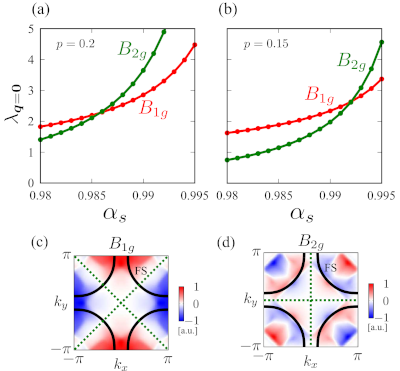Spin-fluctuation-driven B1g and B2g Bond Order and Induced In-plane Anisotropy in Magnetic Susceptibility in Cuprate Superconductors: Impact of Hot-/Cold-spot Structure on Bond-order Symmetry
K. Kawaguchi, S. Onari, and H. Kontani J. Phys. Soc. Jpn. 89, 124704 (2020).
Electronic nematic states in cuprate high-Tc superconductors are not only ubiquitous but also very diverse. Recently, a B1g-symmetry nematic transition around the pseudogap temperature T* has been reported in Y- and Bi-based compounds, whereas B2g-symmetry nematicity has been observed in Hg-based compounds. To understand the reason for the difference in the symmetry of nematicity, we examine the charge-channel density wave states in the d–p Hubbard model based on the spin-fluctuation mechanism, by considering not only the vertex corrections but also the self-energy (Σ) corrections. The former gives the spin-fluctuation-driven charge instabilities, and the latter introduces the hot-spot structure (or Fermi arc structure) on the Fermi surface. When the hot-spot structure is less prominent, the B1g nematicity is obtained robustly. In contrast, the instability of B2g nematicity becomes comparable to that of B1g nematicity when the hot-spot structure is prominent. In both symmetries, the origin of nematicity is bond order, which is the rotational symmetry breaking in the self-energy-driven hopping integrals. In addition, we show that the bond orders induce in-plane anisotropy in magnetic susceptibility due to d,p-orbital angular momenta. Therefore, the symmetry of bond order can be determined by magnetic torque measurement. The present study gives insights into the diverse nematicities in cuprate superconductors.
(Click figure for a larger image.)

